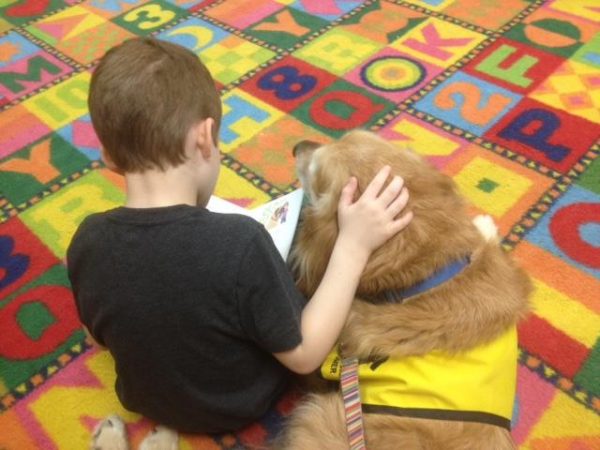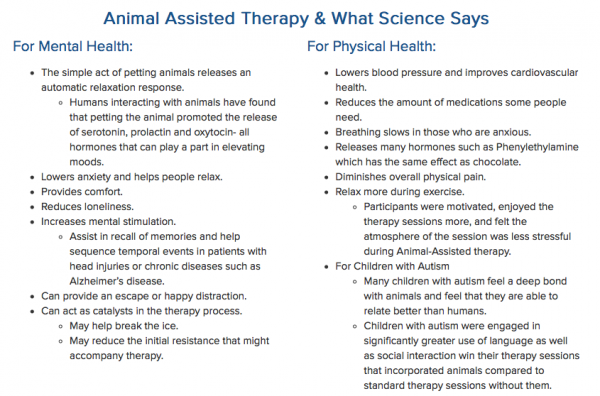ANCHOR: A non-profit group is bringing dogs across central New York to nursing homes, airports and college dorms to help spread smiles and alleviate stress. PAWS of Central New York includes more than 100 volunteers and even two cats. Jenna Webster reports how the simple act of a belly rub is helping change hospital patients, students and the dog owners themselves.
NAT of dog panting
WEBSTER: In third grade, Amy Dumas’ son Jake asked to bring their golden retriever Boomer to school. Dumas’ friend was a volunteer with PAWS and told her how to certify Boomer to visit Jake’s class. That was 13 years ago. Boomer has since been put down, but Dumas has been volunteering ever since. She’s about to certify her fifth dog and is now the president.
DUMAS: “I can’t imagine not being part of it.”
WEBSTER: Years ago–she took Boomer to Minetto Elementary–but the first-grader’s time was up before he finished reading “Henry and Mudge” to the dog.
DUMAS: “He said to Boomer, not to me, ‘hang on a second.’ And he ran in his classroom, ran back out, and he showed Boomer he got a sticky note and put it in the book. And he said, ‘Boomer I’ll finish the book when you come back next month.’ He was just so concerned that Boomer didn’t know the end of the story.”
WEBSTER: Dumas is amazed at what the dogs do.
DUMAS: “I’ve seen dogs crawl–army crawl up the sides of beds…The dogs just intuitively know what to do and where to be.”
WEBSTER: Mike Lollis and his golden retriever Rosie have been volunteering for four years. They spend a lot of time with the residents in the dementia unit at Camillus Ridge. The best part–seeing people light up when they see Rosie.
LOLLIS: “There’s a gentleman over there named Richard that had golden retrievers and he never ever misses a day when we go over there…He gets down on his knees and will rub and pet the dog all over.”
WEBSTER: Researchers at UCLA conducted a study on the benefits of animal assisted therapy and had dogs visit patients with heart failure. After only 12 minutes–their anxiety dropped by 24 percent. At Upstate University Hospital–the volunteer manager–Stephanie Mack sees this difference.
MACK: “Putting a smile on someone’s face, lowering blood pressure, making it one more day in the hospital a little bit easier to be here.”
WEBSTER: The dogs are motivators for some patients.
MACK: “To move, to be social, to eat, to get out of bed, to be more independent.”
WEBSTER: Dumas remembers one volunteer’s experience with a young girl in the hospital when she asked if she could take a picture of the dog.
DUMAS: “She used to put the picture under her pillow because it kept the bad dreams away…The connection she had with the dog just made the difference.”
WEBSTER: Not everything the PAWS volunteers do is as powerful as keeping the bad dreams away. But it’s the small interactions that are important too. Volunteers were at Syracuse University to give students a break from studying.
STUDENT: “This is what I needed. I needed you. Yes I did.”
WEBSTER: In order to go on these visits, dogs must be certified. And it’s not as easy as you may think. Half who come for an obedience evaluation…don’t pass. Another 20 percent fail their test run at the nursing home.
DUMAS: “What we do…not every dog is suited to that.”
WEBSTER: Plus–volunteers must be in sync with their dog. Lollis notices Rosie gets stressed when a lot of kids try to pet her at once.
LOLLIS: “She’ll just sit back and get real stiff, as opposed to where her tail’s wagging all the time.”
WEBSTER: Lollis says Rosie’s taught him to be more responsible. He’s bonded with her more than any other dog.
LOLLIS: “She follows me everywhere in the house.”
WEBSTER: And the dogs know what’s up when they see their yellow vest–time to go to work.
DUMAS: “Don’t take the vest out until you’re ready to walk out the door or they walk all over the house, chase you everywhere, wanna know when they’re leaving.”
WEBSTER: Boomer and Rosie are showing that a dog really is a person’s best friend–and that the wag of a tail or the tap of a wet nose can make all the difference.
NAT of dog scratching
WEBSTER: Jenna Webster, NCC News.







